
The majority of residential solar installations in the US fall into two buckets, direct and third-party ownership. A PV system is considered direct ownership if the homeowner owns the equipment outright and finances the purchase using their own savings or a loan. Third-party ownership (TPO) is exactly as it sounds in which a system is owned, installed and maintained by a third-party. In this ownership model, homeowners enter into a power purchasing agreement (PPA) or may choose to lease the equipment from the third party. TPO currently accounts for roughly ⅔ of all residential systems installed. This figure grew steadily to a peak in 2014 (roughly 75% of residential systems), but now that trend appears to be reversing. Forecasts indicate direct and third-party ownership to each represent about ½ of the residential market by 2020.
With each ownership model standing to constitute large portions of the residential market, it is worthwhile to consider in brief some of the characteristics of each. As mentioned above, a TPO arrangement may come in one of two forms, a PPA or an equipment lease. Under the PPA arrangement the system is installed at no cost to the homeowner, while the PPA locks in an electricity rate (typically lower than the utility) with the third-party to ensure a predictable rate structure. By comparison, leasing a solar system under a TPO arrangement offers a similar experience to leasing a car. Homeowners pay off the system over time with the option to purchase the equipment outright at anytime. Leases can be structured to ensure no up-front system cost or partial system cost depending on homeowner needs.

TPO of solar systems offers several attractive attributes to homeowners. Perhaps most attractive of these characteristics is zero money down up front. Although costs continue to decrease year over year, similar to cars, purchasing a solar system outright requires a sizeable amount of expendable cash. TPO arrangements allow folks who otherwise could not afford solar to lower their utility bills and offset their carbon footprint. Furthermore, TPO efficiently utilizes federal tax incentives for lower-income households looking to go solar. Although the federal tax credits can be carried over a significant federal tax liability is needed to fully capture the up-front benefits of the ITC. Lastly, under TPO, operations and maintenance are most often covered under contract, protecting homeowners from the costs associated with equipment failures and system outage. It is worth noting, however, TPO is not offered/legal is every US state.
Unlike TPO, self financing the ownership of a PV system is not limited by state. Homeowners who wish to self-finance have a few options at their disposal: a cash purchase, a home equity loan or a solar specific loan. Under this ownership model homeowners must seek out a reputable solar installer and negotiate a contract for construction. Unlike TPO direct ownership places the responsibility of system maintenance and repair on the homeowner, same as the ownership of any home appliance.
Although the direct ownership model imposes certain risks not present with TPO, interest in direct ownership in increasing rapidly with the advent of a wide range of new solar loan products available. The most obvious benefit of direct ownership is that all incentives and savings derived from the installed system benefit the homeowner. This includes the federal ITC, offset of electricity consumption, net metering where available and the sale of SRECs. The confluence of falling system costs and the introduction of a wide range of solar-based loans, allows homeowners to reap the benefits of their system that would otherwise be transferred to the third party. Given a standard 5kW system in Massachusetts, it is estimated that direct ownership results in 10 times the value for the homeowner when compared to the same system under TPO.
It is also worth noting that direct-ownership could bolster local and state economies in ways unseen with TPO systems. Installations performed by in-state installers support locally owned businesses and encourage these companies to reinvest revenue close to home, most notably in the form of labor. Together, direct ownership brings value to homeowners and local installers alike.



